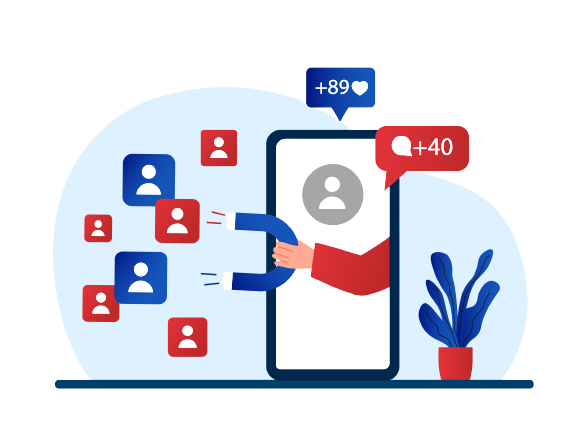
In this extensive guide, you can learn about in-app calling and why it is the missing piece in your omni-channel communication strategy.The business world is highly competitive and demands businesses to be digitally equipped to enhance customer engagement and build lasting relationships. These demands, on the other hand, have resulted in the evolution of Customer Relationship Management (CRM) strategies, and one concept that has gained prominence is “omnichannel CRM.” But within this approach, there’s a significant piece that many businesses often tend to overlook, which is in-app calling. If you are someone who has been overlooking in-app calling or are looking to understand how in-app calling can help your business, then this is the right place for you. But before you start exploring in-app calling features, let’s take a step back to understand the omnichannel CRM revolution.
The Omni-Channel CRM Revolution

Before you dive into the role of in-app calling, you must understand the broader context of omni-channel communication. Omni-channel communication revolves around delivering a seamless and integrated customer experience across all your available channels, starting from your physical stores to your websites, social media, email, and more. The main goal of omni-channel communication is to create a consistent and connected journey for your customers, regardless of how they interact with your business. By acknowledging the fact that customers often switch between various channels during their engagement, the omnichannel communication feature provides a frictionless transition to help you keep your customers engaged and satisfied. This approach can also combine various tools, technologies, and strategies, with your CRM software at its core. As a result, it leverages your CRM systems to collect, organize, and analyze your customer data, to create a more personalized and responsive customer experience.
The Role of In-App Calling in Omni-Channel Communication

In the context of omnichannel communication, in-app calling refers to the feature that allows you to make and receive phone calls directly from within a mobile application or a website. This capability integrates voice communication into your CRM strategies while bridging the gap between your digital interactions and real-time conversations.
In-app calling can variously benefit your business, here’s how it can benefit you while seamlessly aligning with the core objectives of your omnichannel communication:
- Improved Customer Engagement
In-app calling can empower you to engage your customers in real-time conversations within your websites. It provides the option of automated text message and this instant connection eventually fosters deeper interactions, while providing quick and effective assistance, and ultimately enhancing customer engagement.
- Consistency Across Channels
By offering in-app calling and omnichannel communication, an inexpensive CRM can empower you to ensure a consistent customer experience across all your communication channels. Besides, as inexpensive CRMs with in-app calling and omnichannel communication features integrate voice communication into the omnichannel mix, it can allow your customers to connect with your business through their preferred method.
- Personalization
With an appropriate and omnichannel communication feature including in-app calling option, you can also enhance your personalization efforts as this capability of a CRM can generate valuable data, which can enable you to personalize customer interaction. Each call can represent an opportunity for you to gather insights into customer preferences and behaviors, which can eventually enable you to tailor effective omnichannel communication strategies for keeping your customers engaged.
- Real-Time Problem Resolution
The in-app calling option in omnichannel communication can also empower you to address customer concerns or issues in real time. These opportunities will eventually help you to resolve customer issues quickly and boost customer satisfaction in return.
- Data Integration
Inexpensive CRM with omnichannel communication features also provides the opportunity to integrate data from in-app calling into your CRM systems, which can provide you with a 360° view of each customer’s journey. With this data in hand, you can make informed decisions for your marketing, sales, and support strategies, which will facilitate a more data-different approach to customer management.
- Enhanced Sales and Support
Your sales team can also use the in-app calling option from the omnichannel communication feature of an inexpensive CRM to connect with potential leads directly through your company’s website and offer immediate assistance to ensure a responsive customer experience.
Now that you have understood the role of in-app calling in an omnichannel communication feature providing CRM, let’s explore how in-app calling can help you unlock the full potential of your omnichannel communication CRM strategy.
Impact of In-App Calling on Your Omni-Channel Communication CRM Strategy

With its direct line of communication capability and automated text message for business, in-app calling can help you transform customer experience significantly. It can support you to engage your customers in real-time voice conversations and answer their queries promptly, which can not only allow you to establish meaningful interaction but eliminate the chances of your customers feeling frustrated when having to wait for your email responses. Here’s how in-app calling can impact your omnichannel communication CRM strategy:
- Enhanced the Customer Experience
In-app calling can help you transform the customer experience by offering a direct line of communication. So, instead of relying solely on text-based interactions or email, you can engage your customers in real-time voice conversations with your business. Besides, you can also use automated text messages for business features to promptly attend to your customers, even if no one is present to cater to your customers in-person. This can not only allow you to gain more meaningful interactions but eliminate the frustration of waiting for email responses as well.
For instance, imagine a scenario where a customer is exploring your website, encounters an issue, and needs assistance. With in-app calling, they can initiate a call to your support team with a single tap and this instant connection can resolve their problem quickly, leaving the customer with a positive impression of your brand. On the other hand, they can also use the automated text message option for immediate interaction.
- Seamless Transition Between Channels
One of the primary objectives of omnichannel communication CRM is to provide you with a seamless transition between your channels, and in-app calling plays a crucial role in helping you achieve this. When you integrate an in-app calling feature, your customers can start their journey on your website, initiate a call, and then switch back to text-based communication—all without losing context.
For instance, a customer might be browsing products on your website, decide to initiate a call to ask questions, and then later receive follow-up information via email. This transition between channels is effortless, which can provide a smooth and consistent experience.
- Leveraged Personalization and Customer Insights
In-app calling can generate a wealth of data for you, which you can use to personalize customer interactions. With each call, you can collect information about customer preferences, pain points, and behavior, which can then be integrated into your CRM system to create detailed customer profiles and inform future interactions.
Remember personalization serves as a key driver of customer satisfaction and loyalty. By understanding your customers better, you can tailor your marketing campaigns, product recommendations, and support interactions to meet their specific needs and expectations.
- Real-Time Support and Sales
In today’s fast-paced world, customers value real-time support and assistance, and an appropriate in-expensive CRM with an in-app calling and omnichannel communication feature can allow your support and sales teams to connect with customers when they need it most. For your support team, this means they can resolve customer issues in real-time, while for your sales team, it can enable them to immediately follow up with leads and prospects.
For instance, imagine a situation where a customer abandons their online shopping cart. With the in-app calling option of omnichannel communication feature, your sales representatives can proactively reach out to the customer to understand their concerns and potentially close the sale.
- Data-Driven Decision-Making
In-app calling data alongside omnichannel communication data is a goldmine for data-driven decision-making, you can use the abundant data it collects to gain insights into call volume, call duration, call outcomes, and customer satisfaction. This information can help you drive strategic decisions and ultimately optimize your omni-channel communication strategy.
By knowing which channels and communication methods are most effective, you can allocate resources more efficiently and invest in the areas that yield the best results. As a result, this data-driven approach can lead to higher customer retention, increased revenue, and reduced operational costs.
- Integration with CRM Systems
In-app calling isn’t a standalone feature, but to fully realize its potential, you should seamlessly integrate it into your omnichannel communication CRM system. This integration can allow call data to be automatically logged, transcribed, and associated with your customer profiles. So, when a customer calls, their information and history can instantly pop up on the screen of the customer service representative. This immediate access to relevant data can eventually enable more personalized and efficient interactions.
- Competitive Advantage
In today’s competitive landscape, businesses that make it easy for customers to communicate and receive assistance have a significant advantage. By embracing in-app calling of omnichannel communication features, you can stand out as a customer-centric company, which can make it more likely for customers to choose your products or services over those of your competitors.
Is In-App Calling Right for Your Business?

In-app calling undoubtedly offers numerous benefits for enhancing your omnichannel communication CRM strategy, but it’s essential to consider whether it’s the right fit for your specific business. Here are some key factors to evaluate:
- Customer Base: The first factor to consider while analyzing whether or not you need an inexpensive CRM with in-app calling and omnichannel communication features is your customer base. Start by considering the preference of your customer base, and their likelihood to engage with your business through your website. If the answer is yes, in-app calling can be highly effective for you.
- Nature of Inquiries: The next step is to consider the type of inquiries or issues your customers typically report. As in-app calling is particularly useful for complex or urgent matters where real-time communication can make a difference, thus, understanding the nature of inquiries reported by your customers generally can help you ascertain whether or not you need in-app calling from omnichannel communication feature for your business.
- Industry: Certain industries, such as e-commerce, real estate, and on-demand services, can benefit significantly from the in-app calling option of omnichannel communication strategy. However, it can be valuable in many other sectors as well. So, you should analyze the needs and trends in your industry to understand whether or not you should invest in an inexpensive CRM with omnichannel communication in-app calling features.
- Technology Infrastructure: Another important step is to ensure whether or not your technology infrastructure can support omnichannel communication integration. To do so, you should work with CRM systems and possibly third-party tools to implement this feature effectively.
- Regulatory Considerations: Also, remember to be aware of any legal or regulatory considerations related to in-app calling and omnichannel communication in your industry or region.
- Customer Feedback: Finally, seek feedback from your customers, and identify whether or not they are interested in in-app calling and omnichannel communication features. Their input can guide your decision.
How to Implement In-App Calling in Your Omni-Channel CRM Strategy

If you decide that in-app calling and omnichannel communication aligns with your business and customer needs, here’s how to implement it effectively within your omnichannel communication CRM strategy:
- Choose the Right Tools
The first step is to select the appropriate in-app calling solution. You can opt for building it in-house, partnering with a third-party provider, or integrating with an omnichannel communication providing CRM that offers this feature.
- Integrate Seamlessly
Once you have finalized the tool to use, make sure that in-app calling integrates seamlessly with your omnichannel communication providing CRM system and other communication channels. Your goal should be to maintain a unified customer experience.
- Train Your Team
Then focus on providing training to your support and sales teams to make the most of the omnichannel communication feature’s in-app calling option. Ensure that your teams are proficient in using the feature and understand the benefits of the in-app calling feature.
- Promote Awareness
Another important step is to make your customers aware of the omnichannel communication and the in-app calling feature. Highlight its availability and the advantages it offers in terms of real-time assistance and personalized support.
- Collect and Analyze Data
You should also start collecting data from the omnichannel communication feature and analyze this data to gain insights into customer behavior and preferences. You can use these insights to improve your omnichannel communication strategy.
- Optimize and Iterate
Finally, ensure to continuously optimize your omnichannel communication feature and its in-app calling option based on customer feedback and data analysis, as iteration can enhance the effectiveness of your omnichannel communication strategy and in-app calling.
Conclusion: In-App Calling as the Missing Piece
In the realm of omni-channel communication CRM, in-app calling is the missing piece that can elevate your customer engagement and support you to reach new heights. It can enhance customer experience, provide seamless transitions between channels, personalize your interactions, enable real-time support and sales, facilitate data-driven decision-making, and offer a competitive edge. In summary, in-app calling can be the missing piece that takes your omnichannel communication CRM strategy to the next level. By integrating this feature, you can create a more personalized, efficient, and satisfying experience for your customers, ultimately driving success and growth for your business. So, if it aligns with your needs, do not think twice about investing in a CRM that provides automated text message for business options to leverage the benefits of in-app calling and taking your business to new heights of success.